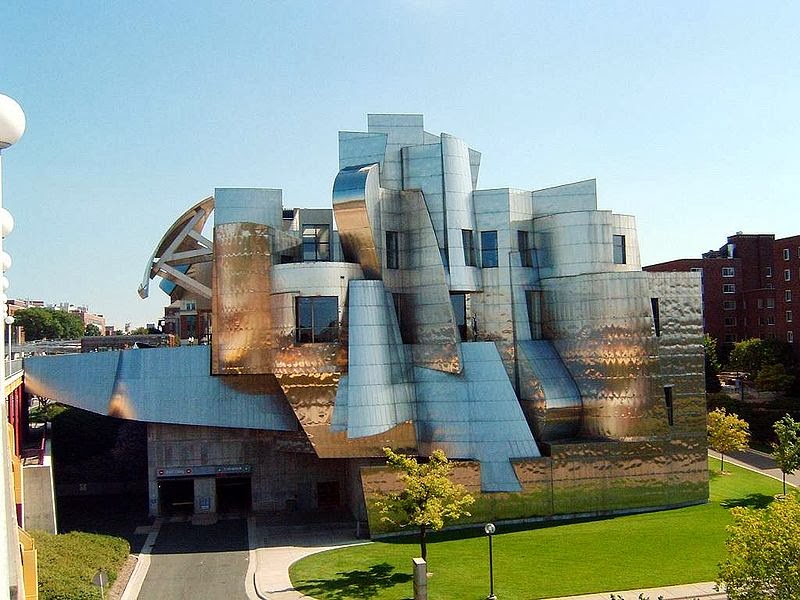
The Frederick R. Weisman Art Museum, University of Minnesota, Minneapolis, MN.
Having recently moved to Minnesota, I became intrigued by the amount of funding and grant programs available for the arts, including many initiatives directed toward funding public art. Although asking why public art and the environment have been recognized as reciprocal concerns is a weighty question, it may simply be that in cities like Minneapolis/St. Paul, where municipal funding for the arts already co-exists with green initiatives, the two go hand in hand.
The permanent placement of public art has demanded an awareness of environmental concerns, from the safety of materials to how normative weather conditions will affect artworks over time. The Weisman Art Museum (where I am currently employed) administers the public art program at the University of Minnesota and has a full-time Curator of Public Art. While this may seem like a small gesture, it allows for art on campus to be treated like any other historical object in a museum collection, requiring routine conservation and discussions of proper storage and exhibition. It is necessary for cities with public art collections to treat them just as such—as collections—whereby the city can continue to maintain them year after year. Maintenance is a huge issue, and with dwindling resources, it’s easy to postpone taking care of art collections. Minneapolis has a maintenance fund for its collection, but there are many works not in the city’s collection that are ignored.
While storage and exhibition in a museum can be regulated through temperature control and security guards (to a degree), public art can often succumb to problems such as lawnmowers scraping against sculpture or the oxidation of bronze sculptures. These issues point to a difficult question for public works—what happens when no one is closely watching the art?
Many initiatives have taken place that put the Twin Cities (Minneapolis/St. Paul, Minnesota) at the forefront of developments in public art. Included within a handful of cities in the United States that follow a “percent for art program”—Philadelphia being the first to pass an ordinance that requires 1% of municipal building costs to go toward the funding and maintenance of public art—the Twin Cities also boasts an Art in Public Places program, the journal Public Art Review, a handful of non-profits dedicated solely to public art, and public art programs administered by area museums. How sustainability has been discussed in the Twin Cities involves more than a notion regarding environmental practices and re-use of materials; it also includes treating art practice as a profession.
In conversation with Jack Becker, Executive Director of Forecast Public Art, a non-profit that also publishes Public Art Review, I asked, “When did issues of sustainability become a relevant issue for public art, and who were the most active proponents of sustainability?” Regarding the intertwined history of art and the environment, he noted that:
The eco-movement in public art began in the 1970s but it wasn’t referred to as “sustainability” and it wasn’t widespread. In the past five years, that has changed. Artists have been at the forefront, and now commissioning agencies are starting to incorporate that criteria more often. LED lighting, for example, is in the majority now. Recycling materials and reducing waste is high on the list of criteria. With a few exceptions, foundations have not been using this term in their criteria for funding; however, they are becoming more responsive to this practice, as is the general public.
Forecast Public Art offers a variety of annual grants for artists to research and develop art projects, without the necessary objective of seeing these projects through to completion. These grants are akin to those given to professors at a college or university level for further development in their respective specialties. Commenting on this aspect of Forecast Public Art, Jack Becker sees this as a “model for supporting artists as independent producers. It is the opposite of commissioning, in that we ask artists what they want to do in public and then give them funding and technical support.” These models of sustainability go beyond environmental concerns to include the sustainability of the artist.
Grant Kester has recently described contemporary art as a practice “displaced from the level of independent ideation on the part of the artist as an indeterminate, [a] collectively authored exchange among multiple interlocuters” (“Questionnaire on ‘The Contemporary,’” October no. 130, Fall 2009). According to this logic, what could be more contemporary than public art, whose discursive networks show art as mediated by not just an artist, but also the various non-profits, city governments, and sites of commercial enterprise? Due to public art’s necessary involvement with the political and social elements of urban infrastructure, it has reveled in a vibrant discourse on how art engages with issues of sustainability, the environment, and the treatment of artists as wage-laborers. The policies enacted by public art organizations offer frameworks for sustainable art practices and funding models that can be utilized beyond the sphere of public art.
Corinna Kirsch is the O’Brien Curatorial Fellow at the Weisman Art Museum in Minneapolis, MN. She would like to thank Craig Amundsen for his thoughtful words on the subject of public art in the Twin Cities.



